
 Chipmunks are fun to watch. With their boldness in search of food and their quick movements, they are not hard to approach or photograph. There are four species of chipmunk in Canada; we'll look at the three that can be found in Alberta. 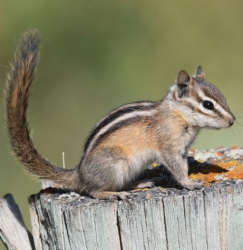 Least Chipmunk
Least ChipmunkRange: Alberta, British Columbia, Manitoba, Northwest Territories, Ontario, Québec, Saskatchewan, Yukon Least Chipmunks are the smallest of all chipmunks. They have five dark and four light stripes along their sides and three dark and two light stripes on the face. Their fur is orange-brown, and their underside is greyish-white. Their tail is bushy, long, and pale brown. 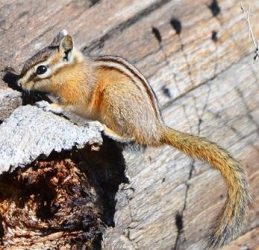 Yellow-pine Chipmunk
Yellow-pine ChipmunkRange: Alberta, British Columbia Yellow-pine Chipmunks are small compared to other chipmunks. They have five black stripes down the back; three dorsal stripes extending from shoulder to rump and two lateral strips extending to mid-body. The pale stripes are usually white or greyish. Their fur varies from tawny to pinkish-brown and their ears are whitish behind and black in front. 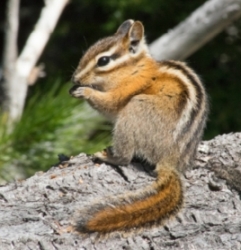 Red-tailed Chipmunk
Red-tailed ChipmunkRange: Alberta, British Columbia The Red-tailed Chipmunk is darker and larger than most chipmunks. It is often reddish-brown on the shoulders and sides. The back is orange-brown, the rump is grey and the underside is whitish. The tail has a black stripe. Red-tailed Chipmunks have five dark stripes, the central one running from between the ears to the tail. Its four pale stripes are greyish to white and it has two pale stripes and three brown stripes on its face. Chipmunks are rodents, and belong to the Squirrel family. All species of chipmunks in Canada live in forested areas. Most live in burrows and gather food on the ground, usually in areas where there are enough rocks, bushes, fallen logs, and piles of brush to shelter them from predators as they scamper about. Chipmunks are solitary animals; each chipmunk has its own burrow and ignores others except when conflicts arise, or during mating. 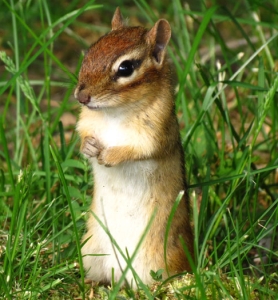 Chipmunks are quite vocal. Walking in the woods, you might not realize that you are hearing them, as some of the cries that chipmunks make are like bird chirps. Biologists have not yet determined the meaning of all their many calls. For example, when a chipmunk is startled, it runs quickly along the ground giving a rapid series of loud chips and squeaks, which may startle predators, helping it escape.
Chipmunks are quite vocal. Walking in the woods, you might not realize that you are hearing them, as some of the cries that chipmunks make are like bird chirps. Biologists have not yet determined the meaning of all their many calls. For example, when a chipmunk is startled, it runs quickly along the ground giving a rapid series of loud chips and squeaks, which may startle predators, helping it escape.Also, chipmunks frequently call with a high-pitched chirp or chuck, repeated over and over at intervals of one or two seconds. This loud scolding noise is often made by a chipmunk watching an intruder, often you, from a safe vantage point. Most chipmunks construct tunnels or holes in the ground. Entrances are well hidden under rocks or bushes. Some western species spend a fair amount of time in trees and may even nest in tree cavities. They need about 15 hours of sleep per day. Chipmunks are known to be hibernators; near the end of July they begin to collect and store large quantities of seeds. By October, each chipmunk has accumulated enough seeds to enable it to survive the winter. It is not known exactly what happens with chipmunk hibernation during the winter. One theory is that they immediately go into a torpid state, where their body temperature, rate of breathing, and rate of heartbeat drop to very low levels, reducing the amount of energy they require. Periods of torpor may last from one to eight days; between periods of torpor, chipmunks wake up and consume part of their food supply. They have occasionally been seen above ground on warm winter days. A second theory is that chipmunks do not actually hibernate until their food supply has been exhausted. In any case, they will emerge from hibernation during the first warm days in March, sometimes burrowing up through a metre of snow. A chipmunk spends much of its day collecting and storing seeds, which are its most important source of food. Although most species of chipmunks usually forage on the ground, they all easily climb trees and shrubs to harvest nuts and fruit. In Canada, in most years, chipmunks have only one breeding season and one litter, but in favourable years a small percentage of adult eastern chipmunks produces a second litter in the fall. No species of chipmunk is found north of the treeline or in prairie grasslands in Canada. 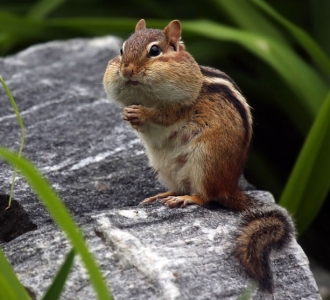
When collecting seeds, the chipmunk holds them in its dexterous front paws, and with sharp cutting teeth, removes the seeds from their pods. Then it uses its tongue to stuff them into the expandable skin in the cheek area, where they are held while the animal collects more food. When the cheek pouches become full, the chipmunk deposits the seeds in its nest, or buries them in shallow holes that it covers with earth, leaves, and other litter. In spring, chipmunks will look for any seeds that remain from the previous summer. They will also eat young leaves until new fruit and seeds become available. During spring, summer, and autumn, their diet can also include insects, earthworms, flowers, berries, cherry and plum pits, mushrooms, and occasionally eggs or flesh of dead animals. Chipmunks have many predators, including hawks, weasels, coyotes, martens, foxes, and snakes. Near populated areas they can also be killed by dogs or cats, or by automobiles. Males fight among themselves when competing for females, and females have been observed defending their nests and young against other chipmunks. Chipmunks are important in the dispersal of seeds because of their habit of storing them under vegetation on the forest floor. Any buried seeds that are not consumed will likely germinate, spreading the growth of shrubs, trees, and other plants. |